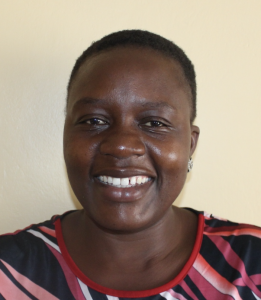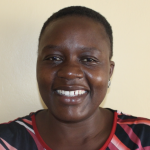Imbinga Community's greatest challenge is to access clean and safe drinking water, a product currently unavailable from their main water source called Nanjendo Spring. People here wake up in the morning's wee hours to go to the spring as early as 6:00 am. For security reasons, people do not go before 6:00 am (or after 6:00 pm) to ensure they are always there in full daylight.
To fetch water, community members must carefully dip small jugs or bowls into the spring to pour into their larger jerrycans; the water is too shallow to submerge their whole container. The more people who fetch water in the same time period, the more mud gets stirred up in the water. People then have to wait even longer for the mud to settle before they can begin fetching again. The process is time-consuming and frustrating, and the containers themselves contaminate the water as they carry and dirt or bacteria from the jugs and people's hands into the water.
Time lost at the spring causes delays in the morning activities, including farming, making and eating breakfast, and going to school and work. The morning delays set the schedule for what else will have to be sacrificed that day, especially if more water is needed in the afternoon or evening.
Since Nanjendo Spring is unprotected and located on a gradual slope, it is prone to contamination from the rains' surface runoff. The runoff carries soil, farm chemicals, animal waste, and other toxins straight into the drinking water. During the rainy season, the water gets so dirty at Nanjendo Spring that the community members have to look elsewhere for water. Some families resort to using small rain tanks in their homes, though not everyone can afford a storage container to act as a tank. Even those families with rain tanks often use the water up before the rains can replenish it anyway. Otherwise, everyone must walk to Arunga Spring, wasting a lot of extra time walking to a completely different part of the village.
Time wastage is at the top of the list of community' members challenges with having to use Arunga Spring since it is not their closest water point. Anyone who typically uses Nanjendo Spring has to wait for all of the usual users of Arunga Spring to draw water first. Conflicts often arise between these community groups as everyone wants to fetch water quickly and go home to start other work. Quarrels also develop within households as children and women face delays in doing their chores and family care work.
"In our family, it's the role of boys to graze and water the animals. The most difficult task is watering our animals as we have 8 cows that drink a lot of water. In most cases, whenever the water gets contaminated [at Nanjendo Spring], and there was no rain, I have to walk to Arunga Spring. I make close to 10 trips a day, and at the end of the day, I am exhausted," said young teenager Denis.
Accessibility is also a challenge at Nanjendo Spring. Whenever community members fetch water, they have to balance while squatting on top of a few rocks carefully they placed to help them stay out of the water. But the rocks, and the surrounding area, are slippery, so many people end up with their feet in the water anyway. This contaminates the water further with whatever soil and bacteria were on their feet and shoes. Because it is open, animals can walk straight through the water while drinking directly from the spring, all while leaving their waste in the area.
"I've been married and in this community for over 13 years, and my greatest and most difficult task is ensuring that my family has safe and clean drinking water," said Gorreti Mbuyachi, a farmer and mother in Imbinga.
"Most of the time, our water gets contaminated, and I have to waste time going to the next nearest protected spring to access clean and safe drinking water. This, in most cases, delays all my daily activities and thus leaves me frustrated. I hope that our spring will be protected so that we can use this time for farming."
Waterborne outbreaks have always been a challenge among families who depend on Nanjendo Spring for water. Children under 5 are the most susceptible to water-related diseases, receiving frequent diagnoses of stomachaches, diarrhea, and coughs due to their dirty water source. Sicknesses force families to use their resources to pay for medicine and care when it could have been spent on their businesses or children's school fees. Time lost to being sick also means less productive time at work for adults and in school for children.
What We Can Do:
Spring Protection
Protecting the spring will help provide access to cleaner and safer water and reduce the time people have to spend to fetch it. Construction will keep surface runoff and other contaminants out of the water. With the community’s high involvement in the process, there should be a good sense of responsibility and ownership for the new clean water source.
Fetching water is a task predominantly carried out by women and young girls. Therefore, protecting the spring and offering training and support will help empower the female members of the community by freeing up more of their time and energy to engage and invest in income-generating activities and their education.
Training on Health, Hygiene, COVID-19, and More
To hold training during the pandemic, we work closely with both community leaders and the local government to approve small groups to attend training. We ask community leaders to invite a select yet representative group of people to attend training, which will then act as ambassadors to the rest of the community to share what they learn. We also communicate our expectations of physical distancing and wearing masks for all who choose to attend.
The training will focus on improved hygiene, health, and sanitation habits in this community. We will also have a dedicated session on COVID-19 symptoms, transmission routes, and prevention best practices.
With the community’s input, we will identify key leverage points to alter their practices at the personal, household, and community levels to affect change. This training will help to ensure participants have the knowledge they need about healthy practices and their importance to make the most of their water point as soon as the water is flowing.
Our team of facilitators will use a variety of methods to train community members. Some of these methods include participatory hygiene and sanitation transformation, asset-based community development, group discussions, handouts, and demonstrations at the spring.
One of the most important issues we plan to cover is handling, storing, and treating water. Having a clean water source will be extremely helpful, but it is useless if water gets contaminated by the time it is consumed. The community and we strongly believe that all of these components will work together to improve living standards here, which will help to unlock the potential for these community members to live better, healthier lives.
We will then conduct a small series of follow-up training before transitioning to our regularly scheduled support visits throughout the year.
Training will result in the formation of a water user committee, elected by their peers, that will oversee the spring's operations and maintenance. The committee will enforce proper behavior around the spring and delegate tasks that will help preserve the site, such as building a fence and digging proper drainage channels. The fence will keep out destructive animals and unwanted waste, and the drainage will keep the area’s mosquito population at a minimum.



 Rehabilitation Project
Rehabilitation Project



































